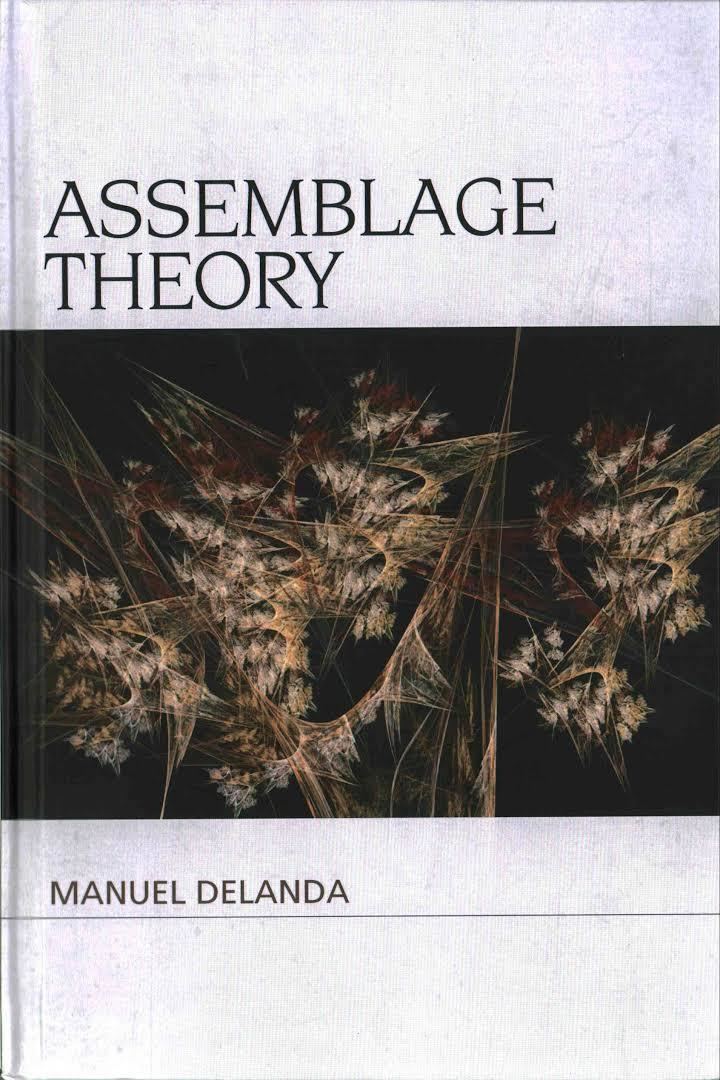Originally published 2016 | ||
 | ||
Manuel delanda assemblage theory society and deleuze 2011
Assemblage theory is an ontological framework developed by Gilles Deleuze and Félix Guattari, originally presented in their book A Thousand Plateaus (1980). Assemblage theory provides a bottom-up framework for analyzing social complexity by emphasizing fluidity, exchangeability, and multiple functionalities. Assemblage theory asserts that, within a body, the relationships of component parts are not stable and fixed; rather, they can be displaced and replaced within and among other bodies, thus approaching systems through relations of exteriority
Contents
- Manuel delanda assemblage theory society and deleuze 2011
- Manuel delanda assemblage theory revisited 2011
- Deleuze and Guattari A Thousand Plateaus
- DeLanda A New Philosophy of Society
- References
Manuel delanda assemblage theory revisited 2011
Deleuze and Guattari, A Thousand Plateaus
In A Thousand Plateaus, Deleuze and Guattari draw from dynamical systems theory, which explores the way material systems self-organize, and extends the system to include that of the social, linguistic, and philosophical in order to create assemblage theory. In assemblage theory, assemblages are formed through the processes of coding, stratification, and territorialization.
Deleuze and Guatarri use the term “constellation” when they talk about assemblage. A constellation, like any assemblage, is made up of imaginative contingent articulations among myriad heterogeneous elements. This process of ordering matter around a body is called coding. According to Deleuze and Guatarri, assemblages are coded by taking a particular form; they select, compose, and complete a territory
In composing a territory, there exists the creation of hierarchical bodies, in the process of stratification. Drawing from the constellation metaphor, Deleuze and Guattari argue that the constellation includes some heavenly bodies but leaves out others; the included bodies being those in close proximity given the particular gathering and angle of view <ref name=SlackandWise />. The example constellation thus defines the relationships with the bodies around it and the way the universe is viewed.
Territorialization is the final process of assemblage theory, and is viewed as the ordering of the coded and stratified bodies that create the “assemblage”. Assemblages territorialize both forms of content and forms of expression. Forms of content, also known as material forms, include the assemblage of human and nonhuman bodies, actions, and reactions. Forms of expression include incorporeal enunciations, acts, and statements. Within this form of territorialization, assemblages do not remain static; they are further characterized by processes of deterritorialization and reterritorialization. Deterritorialization occurs when articulations are disarticulated and disconnected. Reterritorialization describes the process by which new articulations are forged, thus constituting a new assemblage. In this way, these axes of content/expressive and the processes of territorialization exist to demonstrate the complex nature of assemblages.
DeLanda, A New Philosophy of Society
Philosopher Manuel DeLanda has adopted the concept of assemblage in his book A New Philosophy of Society (2006). In his book, DeLanda draws from Deleuze and Guattari to further argue that social bodies on all scales are best analyzed through their individual components. Like Deleuze and Guattari, DeLanda’s approach examines relations of exteriority, in which assemblage components are self-subsistent and retain autonomy outside of the assemblage in which they exist DeLanda further expands upon Deleuze’s assemblage theory and relations of exteriority by suggesting that assemblage components are organized through the two axes of material/expressive and territorializing/deterritorializing. Further, a third axis exists of genetic/linguistic resources exists to define the interventions involved in the coding, decoding, and recoding of the assemblage. However, DeLanda further asserts that the social does not lose its reality, nor its materiality, through its complexity. In this way, assemblages are effective in their practicality; assemblages, though fluid, are nevertheless part of historically significant processes. In that way, DeLanda offers a reconfiguration of the Deleuzian concepts that provides a more robust theoretical framework for analyzing assemblages.
